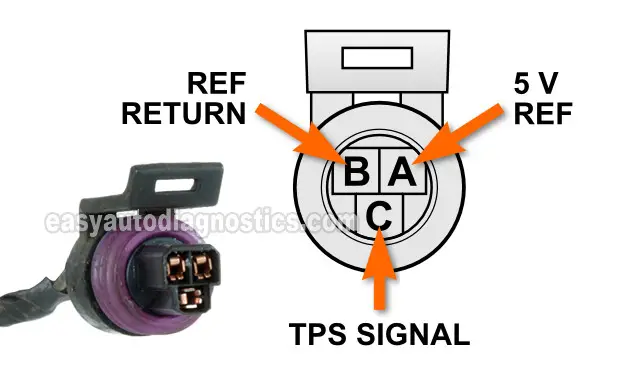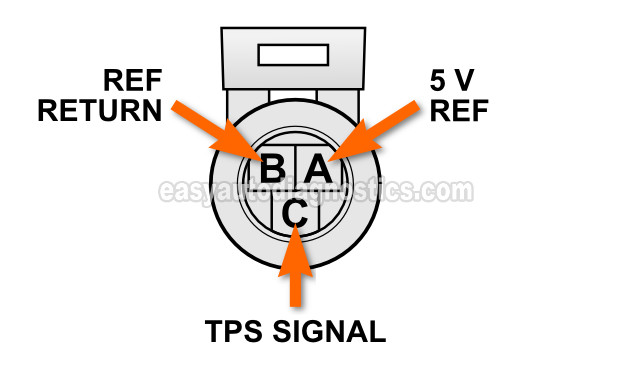
This article will help you to diagnose a bad throttle position sensor on your 3.2L 93-99 Isuzu Amigo, Rodeo, Trooper or Honda Passport.
This is a simple multimeter test that's done in Volts DC mode. No scan tool is required.
Contents of this tutorial:
![]() You can find this tutorial in Spanish here: Cómo Probar El Sensor TPS (1992-1999 3.2L Isuzu Amigo, Rodeo, y Trooper) (at: autotecnico-online.com).
You can find this tutorial in Spanish here: Cómo Probar El Sensor TPS (1992-1999 3.2L Isuzu Amigo, Rodeo, y Trooper) (at: autotecnico-online.com).
APPLIES TO: This TPS test tutorial applies to the following vehicles, since they use the exact same TPS:
- 3.2L Isuzu Amigo: 1998, 1999.
- 3.2L Isuzu Rodeo: 1993, 1994, 1995, 1996, 1997, 1998, 1999.
- 3.2L Isuzu Trooper: 1992, 1993, 1994, 1995, 1996, 1997.
- 3.2L Honda Passport: 1994, 1995, 1996, 1997, 1998, 1999.
Important Tips And Suggestions
TIP 1: The most effective way to test the throttle position sensor on your Isuzu is to test it while the engine is at normal operating temperature. So, if the engine is cold, on your Isuzu, start the engine and let it warm up for about 20 minutes.
TIP 2: All three of the wires that come out of the throttle position sensor connect directly to the fuel injection computer, so you have to be very careful not to short these to 12 Volts, or you'll fry the computer.
TIP 3: You can use a digital or an analog multimeter. Both will work.
Symptoms Of A Bad TPS
You'll have the check engine light on, for sure, on your instrument cluster and one of several of the following symptoms:
- TPS diagnostic trouble codes (DTCs) stored in the vehicle's computer's memory.
- P0121: Throttle Position (TP) Sensor Circuit Performance.
- P0122: Throttle Position (TP) Sensor Circuit Performance/Low Voltage.
- P0123: Throttle Position (TP) Sensor Circuit Performance/High Voltage.
- Really bad gas mileage. You know that it's not the price of gasoline that has you thinking that your Isuzu 3.2L (or 3.2L Honda Passport) is costing you more at the pump.
- Transmission does not shift out of second gear. Now, this doesn't happen very often, but it happens.
- No power and/or hesitation as you accelerate the vehicle. It feels like all of a sudden someone cut the power out momentarily as you step on the gas to get the vehicle moving.
How Does The TPS Work?

In a nutshell, this is how the throttle position sensor works:
- When you turn the Key to the ON position and then start the engine, the TPS gets power thru' the wire labeled with the letter A.
- This power is in the form of 5 Volts.
- These 5 Volts are provided by the PCM.
- Ground is provided by the fuel injection computer thru' the circuit labeled with the letter B.
- Now, the accelerator cable connects to the throttle plate on the engine. The throttle position sensor is bolted to the throttle body in a position where it can measure the amount the throttle plate opens and closes (as you step on or release the accelerator pedal).
- So then, when you accelerate the engine, the throttle plate opens and the TPS immediately measures this and sends this info to the fuel injection computer. This is accomplished thru' the wire labeled with the letter C.
- Now, when you let go of the accelerator pedal, the throttle plate closes and always the alert sentinel, the TPS keeps feeding this change to the fuel injection computer.
- The fuel injection computer uses this info (that the TPS provides) to control fuel injection, ignition advance and a host of other things to keep your engine running smoothly.
Testing the TPS, to see if it's bad or not, simply involves making sure it's getting power and Ground and that it's creating a throttle plate position signal.
Where To Buy The TPS And Save
As you're probably already aware, the original TPS is made by GM (AC Delco). So, if you're looking for the original AC Delco TP sensor, the best place to buy it is online (it's a whole lot cheaper).
The following links will help you comparison shop for the TP sensor:
Disclosure: As an Amazon Associate, I earn from qualifying purchases. Buying through these links helps support this site at no extra cost to you. Thanks for your support —it really means a lot!
Not sure if the above TP sensor fits your particular Isuzu? Don't worry, once you get to the site, they'll make sure it fits. If it doesn't, they'll find you the right one.
TEST 1: Testing The Throttle Position Signal

The very first thing you'll do, is test to see if the throttle position sensor is creating (and thus sending) a good throttle angle signal to the fuel injection computer.
IMPORTANT: The TPS must remain connected to its electrical connector to be able to read the TPS signal with a multimeter. You'll need to use a back probe or a wire-piercing probe to check for the TPS voltage signal in the wire. You can see an example of this tool here: Wire Piercing Probe.
These are the steps:
PART 1:
- 1
Connect the red multimeter test lead to the wire that connects to the terminal labeled with the letter C in the photo.
- 2
Ground the black multimeter test lead on the battery negative (-) terminal.
- 3
Turn the key on, but don't crank or start the engine.
- 4
The multimeter should register about 0.5 to 0.7 Volts DC. If it doesn't, don't worry about it just yet, continue with the other steps.
PART 2:
- 5
Slowly open the throttle plate by hand till it's completely open while you eyeball the voltage displayed by the multimeter.
- 6
The voltage should increase till it stops at about 4.5 to 4.9 Volts DC (once the throttle plate is fully open) without any skips or gaps in the reading.
- 7
Slowly close the throttle plate till completely closed. Your multimeter should show a decreasing voltage till it reaches the voltage you recorded in step 3.
PART 3:
- 8
Have your helper lightly tap the TP sensor with the butt of a screw-driver's handle (or something similar, and I want to emphasize the words 'lightly tap') as you open and close the throttle plate once again.
The tapping SHOULD NOT have any effect on the voltage readings. - 9
Repeat step 8 several times to make sure of your multimeter test results.
Let's interpret your test result:
CASE 1: The voltage increased and decreased smoothly and without any gaps. This is the correct test result and tells you that the throttle position sensor on your Isuzu (or Honda Passport) is OK and functioning correctly.
No need to continue with the other tests in the article since this result also confirms that the TPS is getting both power and Ground.
If the TPS diagnostic trouble code keeps coming back, take a look at the section: TPS Code Won't Go Away.
CASE 2: The voltage DID NOT increase or decrease smoothly and/or you saw gaps in the voltage reading. This test result tells you that the throttle position sensor is bad. Replace the TPS sensor.
CASE 3: The multimeter registered 0 Volts. Generally this test result tells you that the TPS sensor is bad.
But before you replace the TPS, it's important that you make sure that it's getting 5 Volts and Ground. Continue to the next test: TEST 2: Making Sure The TPS Is Getting 5 Volts.



